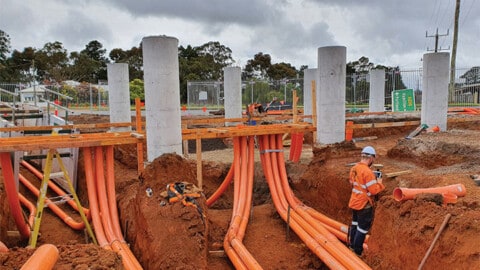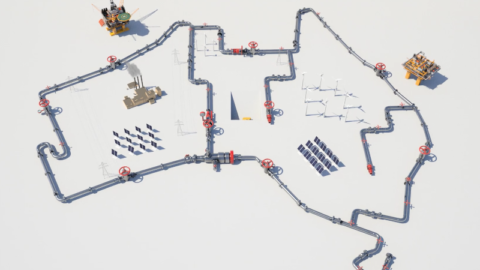By Steph Barker, Journalist, Utility Magazine
The Alice Springs Future Grid Project is a whole-of-systems project that aims to roadmap how Alice Springs can achieve 50 per cent renewable energy by 2030. The $12.5 million project involves collaboration by multiple organisations from across the Northern Territory and Australia, and its purpose is to identify and overcome barriers to further renewable energy use in the Alice Springs electricity system. As part of this project, the Northern Territory Government announced a Territory-first trial to test the economic and energy efficiency of a Virtual Power Plant (VPP). The VPP is a collection of solar and battery storage systems that uses smart technology to control energy flow to and from power grids. Here, we take a deeper look at the VPP, how it pertains to the Future Grid project, and what else is on the slate for Alice Springs’ transition to 50 per cent renewables by 2030.
At present, the Alice Springs power system averages about 10 per cent solar input at any given time. On some occasions, when conditions are just right, Alice Springs can reach 50 per cent solar input – however, this is not the norm.
Additional solar is not currently able to be integrated into the power system due to network challenges, including low fault current, inertia and spinning reserve, and poor frequency control. Following the release of the Roadmap to Renewables report in 2017, the Northern Territory Government set a target for 50 per cent renewable energy by 2030.
The Territory Government, however, recognised that every electricity grid faces challenges with the transition to renewables and no single entity could get the Territory to this renewable energy target. The Intyalheme (in-CHAR-lum) Centre for Future Energy, a flagship project of Desert Knowledge Australia (DKA), is set to play a key role in achieving this target. Intyalheme is an Arrernte word meaning ‘a fire flaring up again’.
The name represents the need to ‘stoke the fire’ by way of leveraging local expertise generated during previous initiatives, to overcome challenges presented by the transition to a renewable energy future. Established with $5 million seed funding from the Northern Territory Government, Intyalheme’s role is to enhance renewable energy capability by bridging gaps in relationships, knowledge, and technologies.
Intyalheme contributes to the 50 per cent renewables goal by leading collaborative projects, sharing existing knowledge and generating new knowledge. The Alice Springs Future Grid project – supported by the Australian Renewable Energy Agency (ARENA), the Federal Government through the Regional and Remote Communities Reliability Fund Microgrids Program and the Northern Territory Government through the Intyalheme Centre for Future Energy – is part of Intyalheme’s broader strategy to help identify and remove the barriers to achieving the renewables target.
The Future Grid is a whole-of-systems project, meaning that the project considers the future the roles and responsibilities of stakeholders in the electricity system and how they will be different from those in place today, as well as seeking to map out what these potential roles, responsibilities and technical capabilities will be.
Alice Springs Future Grid Project Director, Lyndon Frearson, said, “The central premise of the project is actually pretty simple – it’s the idea that the power systems that we imagine for the future will require a different set of relationships between the current participants in those power systems and those that currently exist.”
The $12.5 million collaborative project involves multiple organisations from across the Northern Territory and Australia. Future Grid is delivered through a series of innovative trials, models and investigations. These activities are informing what may need to change in the Alice Springs electricity system to accommodate increasing amounts of renewable energy, while also improving use of the current system.
Future Grid will also design a pathway to achieving the Northern Territory’s 50 per cent by 2030 renewable energy target in Alice Springs, with lessons learned transferable to other grids. “The way organisations and people work within that power system needs to be understood in a manner that allows us to really test the boundaries of responsibilities and accountabilities within those power systems.
These changes don’t just impact how people work, and organisations will need to be able to work in ways that they can’t currently, and in certain cases the are physically prevented from doing so by legislations and regulations,” Mr Frearson said.
Solar VPP: an integral role
The Future Grid project instigated a trial to test the economic and energy efficiency of a Virtual Power Plant (VPP). A VPP is a network of connected solar and battery storage systems that can be coordinated like a pop-up power plant, with the energy drawn from each resource providing a large bank of controllable solar energy.
Smart technology is used to control energy flow to and from power grids, with this energy helping to stabilise the electricity grid and reduce reliance on coal power.
The Future Grid project utilised and coordinated energy from 50 participants involved in the trial, most of whom were residential energy customers with rooftop solar panels and a solar battery. Mr Frearson said, “We know that there’s been some great VPP trials by AGL with Tesla, thousands of homes.
What we’re doing is a lot smaller. It’s only 50 houses, but its a lot harder because what we’re actually doing is dealing with the messiness of reality. We’ve got different size systems, different ages of systems, different battery types and different inverter types that have all been installed by different installers.
And working out how to integrate the messiness of the lived reality of consumers is actually part of the challenge. The trial in and of itself is not unique, but the application of the trial brings us new sets of learnings about how you operate in this system.” The other thing that makes the Future Grid’s VPP trial unique is that it is just one of multiple strategies deployed in the pursuit of renewable energy.
The trial shed invaluable light on how a VPP can work harmoniously with other renewable sources, including:
- Informing how small scale generation can reliably and securely contribute energy into the electricity system to meet security and network needs
- Assisting in meeting peak electricity demand when needed through the coordinated dispatch of stored solar energy
- Support consideration of a framework to unlock value for customers from their solar/ battery systems
Mr Frearson said, “People have done VPPs, grid-forming batteries, modelling, dynamic operating envelopes, and forecasting before. None of those things that we’re doing is in itself unique.
But this we’re considering how all these different pieces work together as part of a system. What is unique about this project is that we’re doing all of those things at the same time so we can understand how they actually rub into each other and cause interfaces.”
So, what data was able to be gleaned from the VPP trial? “The VPP was both a technical and a commercial trial. So the technical elements were around being able to establish dynamic operating envelopes and then remotely setting those limits for the exporting generator from those household systems.
And that’s been quite successful. That part of the integration has actually identified areas of the grid that have higher hosting capacity at a residential level than we might previously have understood,” said Mr Frearson.
“At a commercial level, for the householders, we integrated into the VPP a set of differing tariffing arrangements that were based upon aligning the incentives around when minimum demand was occurring and what we’re actually needing.
One of the things that we are dealing with in the Territory, like in most jurisdictions, is that we’ve spent decades telling people to try and consume more energy at night and less during the day. “But we’re actually dealing now with a regular circumstance where the critical risk to network stability is actually minimum demand in the middle of the day.
So we’re having to get people to say, ‘No, don’t run your washing machine at night, run it during the middle of the day. Don’t do your pool pump at night, do it during the middle of the day.’ So setting up the pricing framework for that was a critical part of the trial.
We did a whole lot of analysis based on average load data to come up with what we thought was the optimal tariffing arrangement, which was within about three or four months of the trial being operational.
We could see that while the tariffs were at work, people were responding to those, but it was actually creating some outcomes where batteries were being charged far too early on in the day and then not being able to absorb that middle of the day surplus,” Mr Frearson said.
Ever-shifting goalposts

Energy loading and streamlining tariffs presented big challenges to balancing the grid and ensuring that enough power is available to customers as required. Another big challenge for the project is the ever-changing landscape of policy and technology.
Planning for the future can be difficult when policies and technologies are evolving so quickly. Mr Frearson said, “We’re developing a systemic project that’s trying to look into the future by testing things in the present, but the things in the present are changing around us.
So, policies changing around us, both domestically and elsewhere around the nation, pricing is changing, the way that people are engaging with all of that is changing while we’re also trying to anticipate how we change the present into the future.
“And that became quite complex for us to work through and to think about, ‘How do we baseline ourselves as we look forward to that?’ So for example, we hit four successive circumstances of minimum demand in four successive periods through last year, and then have hit a minimum demand record again this year.
And because of those minimum demand thresholds are being breached, and Power and Water is then as a system operator compelled to make decisions about how you address that…we are anticipating, ‘Hey, we’re doing this project, we’ll give you a plan that’s going to be a couple of years down the track.’ And they’re having to make decisions now about how to manage it that may itself impact the decision-making process around where we get to in the future.
“So the complexity of change around us and how we respond to that was really significant. And I think, probably one of the biggest single things that I found difficult to manage and to lead, and I came into the project partway through was for a project of this complexity and the coordination of it through COVID and all the rest of it where we are obviously an industry overall that is suffering significant resourcing constraints and that’s even more so in the territory.”
Embracing uncertainty
The VPP trial was subproject four of the Future Grid project. Subproject one looked at modelling and developing differing modelling techniques for these types of grids, and different optimisation techniques for batteries and minimum demand.
Subproject two examined the role of grid forming inverters within embedded networks and the extent to which those embedded networks start to connect and disconnect from the grid to support the future operation of the grid.
Subproject three looked at customer and consumer engagement. Subproject four was around the VPP, and subproject five examined activities around network and operator integration around the establishment of dynamic operating envelopes, forecasting and a range of activities.
The five subprojects were designed to help answer the burning question – how does the Territory get to 50 per cent renewable energy by 2030? The answer lies not just with technology, but with adaptability and a commitment to change.
“We recognise that much of the language of power systems transition to date has largely been in response to the language of denial. We’ve had many years of, ‘We don’t need to change, it’s not going to be a problem.’ And, the counter to that is, that the change is just continuing to do what we’ve always done, but with renewables.
In that model, you end up with the same power structures, the same level of influence around different organisations, but what you actually uncover is that in the world that we’re moving toward in 2030, where you may actually have to go engines off for period of time, substitution doesn’t cut it anymore because you actually need to completely reframe your thinking.
We’ve reached the limits of substitution already and that then means you go into this transformation environment,” Mr Frearson said. “The world in which we’re operating, uncertainty shouldn’t be regarded as a bug: it’s actually a feature.
This then means the way we talk, the way we communicate, the obligations that we place on different organisations have to take that uncertainty into account, both as an opportunity but also as a cost or a risk in the work we do, and future grids really trying to recognise and value that.”














